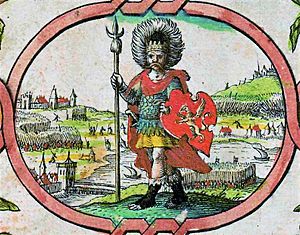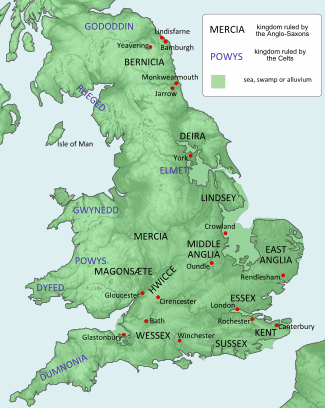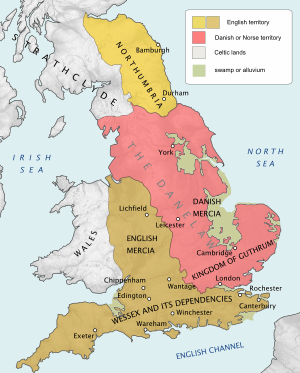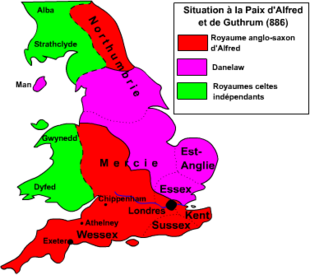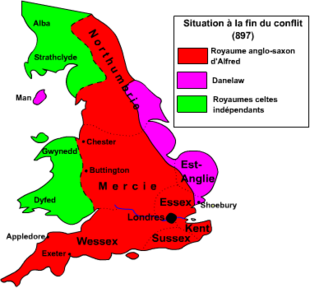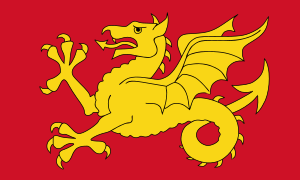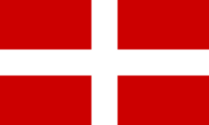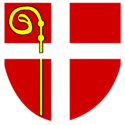Wessex facts for kids
Quick facts for kids
Kingdom of the West Saxons
|
|||||||||||
|---|---|---|---|---|---|---|---|---|---|---|---|
| c. 519–886 | |||||||||||
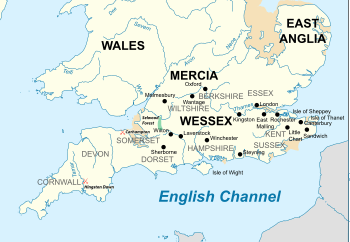
Southern Britain in the ninth century
|
|||||||||||
| Status | Independent kingdom (c. 519 – c. 645; 648–886) Client state of Mercia (645–648) |
||||||||||
| Official languages | Old English | ||||||||||
| Religion | Paganism (before 7th century) Christianity (after 7th century) |
||||||||||
| Government | Monarchy | ||||||||||
| King (List) | |||||||||||
|
• c. 519 – c. 534
|
Cerdic (first) | ||||||||||
|
• 688–726
|
Ine | ||||||||||
|
• 802–839
|
Ecgberht | ||||||||||
| History | |||||||||||
|
• Established
|
c. 519 | ||||||||||
|
• Alfred the Great declares himself as King of the Anglo-Saxons.
|
886 | ||||||||||
| Currency | Penny | ||||||||||
|
|||||||||||
| Today part of | |||||||||||
The Kingdom of Wessex was an important Anglo-Saxon kingdom in the south of Great Britain. It existed from about 519 AD until 886 AD. In 886, Alfred the Great declared himself the King of the Anglo-Saxons, which marked a big change for Wessex.
Many Anglo-Saxons believed that Wessex was started by two leaders, Cerdic and Cynric. However, some historians think this might be a legend. Wessex became a Christian kingdom after King Cenwalh was baptised in the 7th century. The kingdom grew bigger under his rule.
Later, King Cædwalla conquered nearby kingdoms like Sussex and Kent. His successor, King Ine, created some of the oldest laws in England. He also set up a second church area (bishopric) in Wessex.
During the 8th century, a powerful kingdom called Mercia grew strong. But Wessex managed to stay mostly independent. This was when the system of shires (like counties today) was created. Under King Egbert, Wessex became even more powerful. He conquered many areas, including Mercia for a short time.
The Danes invaded Wessex in 871. King Alfred had to pay them to leave. They returned later but were eventually defeated by Alfred at the Battle of Edington. Alfred was a great king. He created new laws, brought scholars to his court, and built ships and forts to protect his kingdom.
Alfred's son, Edward, took back lands from the Danes. His grandson, Æthelstan, conquered Northumbria in 927. This made England a single, unified kingdom for the first time. Later, in 1016, Cnut the Great conquered England. He created a powerful earldom of Wessex. But in 1066, Harold Godwinson became king, and Wessex stopped being a separate political area.
Exploring Wessex's Past
Early History of the Region
From the Neolithic period (New Stone Age) onwards, the chalk hills of what would become Wessex had ancient paths. One famous path was the Harrow Way, used for trading tin. During the Bronze Age, important ceremonial sites like Avebury and Stonehenge were built on Salisbury Plain. These places show how advanced the people of the "Wessex culture" were.
The area also has many other old earthworks and stone monuments. These include the Dorset Cursus, a long earthwork that was probably used for ceremonies. Even though people farmed and hunted, we don't find much evidence of their homes from this time. By the Iron Age, different Celtic British tribes lived in the future Wessex area.
Roman Influence in Britain
After the Roman conquest of Britain in the 1st century AD, many Roman country homes (villas) and farms were built across Wessex. Important towns like Dorchester and Winchester also grew. The Romans built major roads connecting these towns to other parts of Britain, like London.
In the mid-4th century, Roman Britain faced more attacks from different tribes. In 367, these tribes invaded Britain from all sides. A Roman general named Theodosius managed to take back most areas. But later, a Roman leader named Magnus Maximus took many soldiers from Britain to fight in other parts of the Roman Empire.
By 410 AD, the Roman Emperor Honorius told the people in Britain to defend themselves. This meant the Romans were leaving. After this, the economy declined. Roman coins were no longer used, and goods from the Roman Empire stopped arriving.
Anglo-Saxon Arrival in Britain
Historians have different ideas about how the Saxons, Jutes, and Angles settled in Britain. One idea comes from Welsh writings, and another from English writings.
The Welsh Story
The Welsh story, told by a writer named Gildas, says that after the Romans left, the Celtic Britons were doing okay. But when northern invaders attacked, a British ruler asked the Saxons for help. In return, the Saxons were given land.
At first, there was peace between the Britons and Saxons. But then, a fight over food supplies started a war. The Saxons caused a lot of damage. Later, some Saxon troops left Britain. The Britons, led by Ambrosius Aurelianus, then defeated the Saxons who remained.
A long war followed, with no clear winner. This changed when the Britons won a big victory at the Battle of Mons Badonicus. After this, the Britons had a peaceful time.
The English Story
One English story about the Saxons involves Hengest and Horsa. A writer named Bede added details to Gildas's story. He named the British ruler Vortigern and the Saxon leaders Hengest and Horsa.
More details were added in another book, the Historia Brittonum. It says Hengest and Horsa fought invaders for Britain in exchange for the Isle of Thanet. Vortigern later married Hengest's daughter, Rowena.
However, a war started in Kent. After losing battles, the Saxons tricked the British by attacking them during a meeting. The Anglo-Saxon Chronicle adds more details to this legend. It also records other Saxon arrivals, including Cerdic, who founded Wessex in 495.
The Anglo-Saxon Chronicle's Account
The Anglo-Saxon Chronicle says that Cerdic of Wessex and his son Cynric of Wessex landed in southern Hampshire in 495. But historians don't fully trust this account. It might have errors, and evidence suggests the area was first settled by Jutes.
The Chronicle also says that Cerdic and Cynric killed a British king named Natanleod in 508. Cerdic then became the first king of Wessex in 519. In 519, the Saxons attacked Cerdicesford. This battle seems to have been a draw, and Wessex's expansion stopped for about 30 years. This was likely due to losses and a peace agreement with the Britons.
The Battle of Mons Badonicus, where the Saxons were completely defeated, probably happened around this time. The Chronicle doesn't mention this defeat. The peace was broken in 530 when the Saxons conquered the Isle of Wight.
Cynric became king after Cerdic died in 534. He ruled for 26 years. Ceawlin became king after Cynric around 581. His rule is thought to be more accurately recorded. Ceawlin conquered British areas to the northeast. In 577, he captured Cirencester, Gloucester, and Bath. This opened the way to the southwest.
Ceawlin was considered a powerful ruler, a "Britain-ruler" (bretwalda). He was later removed from power, perhaps by his nephew, Ceol. The kingship then passed through several other rulers.
Some historians doubt the early stories of the West Saxon kings. This is because some early kings, like Cerdic, Ceawlin, and Cædwalla, had British Celtic names, not Anglo-Saxon ones. This might mean that Cerdic was a native Briton, and his family became more Anglo-Saxon over time.
Wessex Becomes Christian
A very important event happened during King Cynegils's reign: he was baptised by Birinus around 640. This was the first West Saxon king to become a Christian. Birinus became the bishop of the West Saxons.
However, not all West Saxons became Christian right away. Cynegils's successor, Cenwealh, was a pagan when he became king in 642. But he was baptised a few years later, and Wessex became a strong Christian kingdom. Cynegils's conversion might have been linked to an alliance against King Penda of Mercia, who had attacked Wessex.
These attacks from Mercia put pressure on Wessex. Over time, Wessex lost lands north of the Thames. This made the kingdom focus more on its southern territories. Cenwealh married Penda's daughter, but when he sent her away, Penda invaded and forced Cenwealh into exile for about three years. During his exile, Cenwealh became Christian.
After returning, Cenwealh faced more attacks from Mercia. But he also expanded Wessex into Somerset, taking land from the Britons. He set up a second bishopric in Winchester.
After Cenwealh died in 673, his wife, Seaxburh, ruled for a year. Then, Æscwine became king. He was from a distant branch of the royal family. This happened several times, where the kingship went to distant relatives. These claims might have been made to make new rulers seem more legitimate.
Æscwine ruled for only two years. In 676, the throne went back to Cenwealh's family with Centwine of Wessex. Centwine fought and won battles against the Britons, but we don't know the details.
Cædwalla, another distant relative, became king after Centwine. He ruled for only two years but greatly expanded the kingdom. He conquered Sussex, Kent, and the Isle of Wight. However, Kent soon became independent again. Cædwalla ended his reign in 688 by giving up his throne and going on a pilgrimage to Rome, where he was baptised and died.
His successor was Ine, who also claimed to be related to Cerdic. Ine was one of the longest-ruling West Saxon kings, reigning for 38 years. He created some of the oldest English laws that still exist today. He also set up a second bishopric at Sherborne. Near the end of his life, he also went on a pilgrimage to Rome. After Ine, the throne passed to other kings whose family connections are not fully clear.
During the 8th century, Mercia was very powerful, and Wessex was sometimes under its influence. But Wessex managed to keep more independence than smaller kingdoms. Wessex continued to expand westwards, taking over much of Dumnonia (Devon). By this time, Wessex controlled much of Devon, though Britons there kept some independence until the 10th century.
The Thames and Avon rivers likely formed Wessex's northern border. Its main area included Hampshire, Wiltshire, Berkshire, Dorset, and Somerset. The system of shires, which later became the basis for local government throughout England, started in Wessex by the mid-8th century.
Wessex's Rise and Viking Attacks
In 802, the future of Wessex changed with King Egbert. He came from a different branch of the royal family. With him, the throne stayed firmly within one family line. Early in his reign, he fought against the "West Welsh" (Britons) in Devon and made Cornwall a vassal state.
In 825 or 826, he defeated King Beornwulf of Mercia at Ellendun. This allowed Wessex to take control of Surrey, Sussex, Kent, and Essex from Mercia. With Egbert's help, East Anglia also broke free from Mercian control. In 829, he conquered Mercia and became the "Bretwalda," or high king of Britain. This powerful position didn't last long, as Mercia regained its independence in 830. But Wessex's control over southeastern England remained.
Egbert's later years saw the start of Danish Viking raids. These attacks happened often from 835 onwards. In 851, a huge Danish army arrived. After defeating Mercia, the Danes invaded Wessex. But King Æthelwulf, Egbert's son, crushed them at the bloody Battle of Aclea. This victory stopped Danish conquests in England for 15 years, but raids on Wessex continued.
In 855–856, Æthelwulf went on a pilgrimage to Rome. His oldest son, Æthelbald, took advantage of his absence to seize the throne. When Æthelwulf returned, they agreed to divide the kingdom to avoid war. Æthelwulf ruled the new eastern lands, while Æthelbald kept the old western heartland.
Æthelwulf was followed by his four sons, one after another: Æthelbald, then Æthelbert, then Æthelred, and finally Alfred the Great. This happened because the older brothers died in wars with the Danes without having children. Æthelred's sons were too young to rule when their father died.
The Last English Kingdom
In 865, several Danish commanders formed a large army, known as the Great Heathen Army. They conquered Northumbria and East Anglia. Then, in 871, the Great Summer Army arrived from Scandinavia. This reinforced army invaded Wessex. Even though King Æthelred and Alfred won some battles, they suffered heavy losses. Alfred was forced to pay the Danes to leave Wessex.
The Danes spent the next few years conquering Mercia. Some settled in Northumbria. But the rest returned to Wessex in 876. Alfred managed to make them leave in 877 with little fighting. A part of the Danish army settled in Mercia. But in early 878, the remaining Danes launched a surprise winter invasion of Wessex. They took over much of the kingdom.
Alfred had to hide with a small group of followers in the marshes of the Somerset Levels. But after a few months, he gathered an army and defeated the Danes at the Battle of Edington. This forced them to finally leave Wessex and settle in East Anglia.
Alfred then made big changes to Wessex's government and defenses. He built warships, organized the army into shifts, and created a system of fortified towns called burhs. A 10th-century document, the Burghal Hidage, lists 33 forts. These forts were placed so that everyone in Wessex was within a day's ride of a safe place. In the 890s, these changes helped Alfred fight off another huge Danish invasion with few losses.
In 2015, a large treasure of Saxon jewelry, silver, and coins was found near Leominster. The coins date to around 879 AD. Experts believe a Viking buried the treasure during raids when Alfred the Great ruled Wessex and Ceolwulf II ruled Mercia. Two coins show both kings, suggesting they had an alliance for a time. However, these coins are rare, which might mean Alfred quickly stopped his alliance with Ceolwulf.
Alfred also improved justice, issued new laws, and encouraged learning. He brought scholars to his court. With their help, he translated many Latin texts into English, doing much of the work himself. He also organized the writing of the Anglo-Saxon Chronicle. Because of these efforts and Wessex's power, the West Saxon dialect became the standard written form of Old English.
|
|
|
|
The Danish conquests had destroyed the kingdoms of Northumbria and East Anglia. Mercia was divided, with Danes settling in the northeast. The southwest was left to an English king, Ceolwulf, who some say was controlled by the Danes. When Ceolwulf's rule ended, "English Mercia" was ruled by an ealdorman (a high-ranking noble), Aethelred. He accepted Alfred's authority and married Alfred's daughter, Ethelfleda. This made Alfred the only remaining English king.
England Unites and Wessex Changes
After the invasions of the 890s, Wessex and English Mercia continued to be attacked by Danish settlers and small raiding parties. But these attacks were usually defeated. The English steadily gained more power. In 911, Ealdorman Æthelred died. His wife, Alfred's daughter Æthelflæd, took charge of Mercia.
Alfred's son and successor, Edward the Elder, then added London, Oxford, and surrounding areas to Wessex. Between 913 and 918, English forces defeated the Danes in Mercia and East Anglia. This brought all of England south of the Humber under Edward's control. In 918, Æthelflæd died, and Edward took direct control of Mercia. This ended Mercia's independence and ensured there would be only one Kingdom of the English.
In 927, Edward's successor, Æthelstan, conquered Northumbria. This brought all of England under one ruler for the first time. The Kingdom of Wessex had grown and transformed into the Kingdom of England.
Even though Wessex was now part of a larger kingdom, it still had its own identity. After King Eadred died in 955, his nephew, Edwy of England, became king. But Edwy was not popular. The nobles and church leaders in Mercia and Northumbria declared their loyalty to his younger brother, Edgar the Peaceful, in 957. Edwy continued to rule in Wessex. In 959, Edwy died, and all of England came under Edgar's control.
After the Danish king Cnut conquered England in 1016, he created earldoms based on the old kingdoms. He ruled Wessex himself at first. But within a few years, he created an earldom of Wessex for his English supporter, Godwin, Earl of Wessex. This earldom covered all of England south of the Thames.
For almost 50 years, the very wealthy holders of this earldom, first Godwin and then his son Harold Godwinson, were the most powerful men in English politics after the king. Finally, when Edward the Confessor died in 1066, Harold became king. This reunited the earldom of Wessex with the crown. No new earl was appointed before the Norman Conquest of England. The Norman kings soon got rid of the large earldoms. So, 1066 marks the end of Wessex as a political unit.
Symbols of Wessex
The Wyvern or Dragon
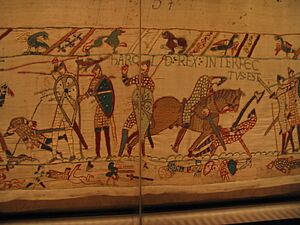
Wessex is often represented by a wyvern or dragon.
Some old texts mention a golden dragon being used by the West Saxons in a battle in 752. The Bayeux Tapestry shows a fallen golden dragon and another dragon near King Harold II when he died. Harold was previously the Earl of Wessex. Dragon flags were common in Europe at the time, coming from Roman army standards. There's no clear proof that the dragon was only for Wessex.
An 18th-century stained glass panel in Exeter Cathedral shows a dragon image linked to southwest Britain before the Victorian period. However, the dragon became strongly linked with Wessex in the 19th century, thanks to writers like E. A. Freeman. By 1911, a red dragon was the accepted symbol for the former kingdom. This was followed by other county councils in the region.
In the British Army, the wyvern has been used to represent Wessex. The 43rd (Wessex) Infantry Division used a gold wyvern on a black or dark blue background. The Wessex Brigade also used a cap badge with the heraldic beast. The Royal Wessex Yeomanry adopted a similar symbol in 2014.
When Sophie, Countess of Wessex was given her own armorial bearings, a blue wyvern was included. It was described as "an heraldic beast which has long been associated with Wessex."
In the 1970s, William Crampton designed a flag for the Wessex region. It shows a gold wyvern on a red background.
Cross of Saint Aldhelm
A white cross on a red background, known as the Flag of Saint Aldhelm, is sometimes used as another symbol for Wessex. Saint Aldhelm's feast day on May 25 is also celebrated as "Wessex Day." This flag is like an upside-down Cross of Saint George. It is also thought to come from the arms of Sherborne Abbey in Dorset.
Wessex Coat of Arms
Medieval heralds (people who design coats of arms) created a coat of arms for the Kings of Wessex. These arms appear in a 13th-century manuscript. They are described as a blue shield with a cross that has flowery ends, and four small birds (martlets) in gold.
The attributed arms of Wessex are also known as the "Arms of Edward the Confessor." The design is based on a symbol used by King Edward the Confessor on his coins. This heraldic design continued to represent both Wessex and Edward in traditional heraldry. It can be seen in church windows, like the arms of Westminster Abbey, which the king founded.
See also
 In Spanish: Reino de Wessex para niños
In Spanish: Reino de Wessex para niños


